CRM lead generation involves using a CRM (customer relationship manager) to nurture relationships between you and your leads (potential customers) and existing customers. With a CRM you can manage client or customer information for any size business with greater efficiency and autonomy. Using a CRM for lead generation means closing more deals, increasing sales, and improving real-time decision making and long-term forecasting.
Business owners who utilize CRM lead generation forever alter the effectiveness of their business. Did you know that sales staff only spend about 36.6% of their time actually selling? What if you could institute an intuitive and convenient system that would allow you or your salesperson to spend more time building relationships and closing deals? As a business, your most important asset is your customer or client. Without a CRM, the details regarding these individuals are spread amongst you, your marketing team, your sales force, your accountant etc. - in their brains, inboxes, and stacks of invoices. Centralizing, sorting, and filtering all customer and sales information is what a CRM does best. Proper CRMs like those from Hubspot allow you to manage relationships and sales funnels without fighting overly complicated spreadsheets and hours of data entry. Organization is effortless with a CRM - you can manage your sales funnel with total visibility. You can also see all of the details related to a lead in one place including notes, interactions, and touch points. This allows you to visualize and make sales forecasts.
A proper CRM centralizes and brings all of your customer information together in one place. This is the first step toward increasing the efficiency of your business. Instead of employees using multiple spreadsheets, binders or databases, they'll have all of the relevant information for any given customer right at their fingertips and in one place. A CRM does require you to enter customer data at some point, but there are ways that you can automate this process and how the information makes it into your CRM. Website contact forms are a prime example. Instead of manually recording interaction with an email every time a customer contacts you, you can feed their entries through a contact form to your CRM. The conversation then gets recorded and the sales process begins. From this point, anyone could go back, reference that conversation and seamlessly pick up the sales process.
If you're storing customer information in hard-copy books or binders you stand to lose that information or misrecord entries. One of the biggest benefits of a CRM is having the ability to organize, sort, segment, filter and apply conditions to all of this information. Not only is customer info stored and backed up within a CRM, but you now also have more advanced ways of interpreting it. CRMs really derive their power from these advanced filters and conditions. These allow you or any other user the ability to group contacts and customers into any type of segment. When you group customers into segments, you can then specialize the interactions or messaging to suit that grouping. Before a lead becomes a customer there's often a lot of nurturing that takes place. You want to make sure that your sales staff knows who's ready to buy. They also need to know and what type of messaging they need to deliver to close the deal.
You need a CRM if multiple employees interact with a contact or lead before the sale or deal actually occurs. If there are multiple points of contact, each person needs to know what communication the lead last received. Keeping track of multiple conversations in multiple places at multiple times increases your chances of closing more deals. Because a CRM provides a single access point for all customer details. You'll always know exactly where a lead is at in their journey to becoming a buyer. Everyone on your team will know which leads need more nurturing, communication or information and which leads are ready to buy.
You need a CRM if you want to automate some of the repetitive interactions that take place between you and your customer. By automating the more repetitive and mundane aspects of your business, you stand to save time and money and reduce overall labor. Here are just a few things you can automate with a CRM:
Analyzing trends is critical to your business's future growth and development. The problem is having the right information displayed to you in the right way. Without this, you can't see the trends. With a CRM all of your information for customers and sales is in one, highly filtered and organizable space. With all of this customer and sales info, you can now apply filters to make interpretations and predictions. For instance, knowing a customers lifetime value (LTV) is crucial. This allows you to understand how their repeated business factors into your bottom line and total ROI. Using a CRM means that you have a historical view of all existing and future customers.
If you're still not convinced that CRM lead generation is right for your business, you may be right. A CRM is not perfect for everyone. It's intended for those who are interested in scaling up their business by managing information, spotting trends and making decisions that benefit their future. Talk to us if you're unsure about a CRM and how it can help you. We can assess your needs and steer you in the right direction. As part of our commitment to our clients, we provide each with a CRM regardless.
In a recent post, I told the story of a client that enjoyed $550,000 in new revenue from online lead generation during the first 7 months of 2017. In actuality, the total is significantly higher, since that only includes form fills, and not web-generated phone calls. For the purpose of this discussion, form-fill data works just fine. Let me provide some context and break that down a bit. Prior to the start of our campaign, this company was averaging $5.5M annual revenue. $0.00 of that was generated by attracting new business online. I should mention that our efforts began a few months prior to January 1st., so we had a bit of runway leading up to FY17. Monthly, $550K breaks down to $78,571.43. Annualized, that’s a pace of just over 17.1% year over year. To understand what that means in terms of ROI (return on investment), we’ll need to dig a little deeper. Two key metrics are (1) the number of customers making up that revenue; and (2) how many times each customer will purchase over a lifetime. We know the cost of the contract, so we can calculate the cost per acquisition (CPA), as well as the lifetime value (LTV) for every new customer attracted through SEO. The formula is simple: ROI = LTV - CPA Determining the cost per acquisition is also simple. Just add up all the promotional costs and divide by the number of new customers generated from those efforts. Lifetime value is the amount each of those customers spends. If you are calculating the total return for a given effort, count all of the customers attracted by the campaign. For the above campaign, monthly sales of $78,571.43 represents 3.4 customers. So the average revenue per sale is $23,109.24. Most customers spend that annually and stick around for at least 3 years. Lifetime value (LTV), then, is $23,109.24 X 3, or $69,327.73. Still with me? The entire cost is the amount spent on SEO, which happens to be $5,500 per month. We just divide that by 3.4, the average number of customers acquired through online search in a given month. $5,500 ÷ 3.4 = $1,617.65. Now we can calculate the actual ROI using the formula. ROI = $69,327.73(LTV) - $1,617.65(CPA) ROI = $67,710.08 per month. ($812,520.96 per year) As a side note, that’s a CPA of about 2.4% of revenue. Most industries establish their marketing budgets around 4% to 6%, so 2.4% is very low. Obviously, not every business sells $23,000+ items, but the ratios are the same for every business. It is the relationship between CPA and LTV that determines the success of any marketing effort. It’s what our clients are really interested in, even if they’re not used to thinking in those terms. So, as you put together a plan leading into next year, using hard data in your lead generation planning will keep your forecasts as accurate as possible. Maintaining the relationship between revenue from each generated lead, relative to the cost of acquiring it, will also help you scale your plan.
 Tim Ash
Tim Ash Beginning now, we are introducing a weekly post recognizing top Internet marketers for their contributions. Our goal is to help business owners, marketing managers and others gain a broader understanding of the marketing landscape as it exists today.
Beginning now, we are introducing a weekly post recognizing top Internet marketers for their contributions. Our goal is to help business owners, marketing managers and others gain a broader understanding of the marketing landscape as it exists today.
These are the thinkers and pioneers in online marketing. They’re the people we pay attention to and learn from, while we develop cutting edge technologies of our own. Hopefully, in learning a bit about them, you’ll be inspired to take your own marketing efforts to ever greater heights.
I first learned of Tim Ash in 2007 when I read his book, Landing Page Optimization. By then, I already had several years of digital marketing experience behind me—especially SEO and conditional messaging, and sales-pipeline kinds of activities.
In the 2-3 years prior, I had begun formulating my own ideas about how marketing, especially online, was more of a statistical exercise than an artistic one. It was Tim Ash’s book that solidified my thinking, and gave words to what had previously been vague ideas and thoughts.
Even today, I recommend Landing Page Optimization to all of our newly hired Internet Marketers at OCG. Around here, Landing Page Optimization is referred to simply as “the book.” Save for the expected evolutions in available technologies, “the book” is a relevant today as it was in 2007.
Tim Ash is the President & CEO of a company called Site Tuners, a CRO (conversion rate optimization) firm that works with large organizations to ensure the highest possible ROI for their online efforts.
His Ph.D. studies were in Neural Networks and A.I., and he has a Master’s degree in computer science…. So, enough said about qualifications.
In many ways, we build and utilize landing pages the way we do today, because of the effort of Tim Ash back in the 1990s. I was an Internet Marketer at that time, working with some of the very first companies engaged in this new concept, e-commerce. That was before Google, and the search leaders were companies like HotBot, Inktomi and Ask Jeeves!
To imagine someone like Tim, with the foresight to analyze consumer behavior at a time where we were just focused on getting our SSL connections to work is amazing to me. It’s also humbling.
So, thank you, Mr. Ash. You’re an inspiration to me, and a great resource for our company.
If you’d like to learn more about Tim Ash, visit http://sitetuners.com/about/management/tim-ash/.
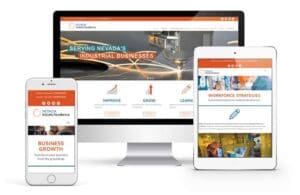 Designing a website for website lead generation is a tough business. Pulling together a great visual design with interesting content is relatively easy, but doing these things in a way that encourages people to fill out a contact form is a different story. The trick to creating great lead generating websites is designing a site flow that makes sense to a user and caters to the process they use to decide whether to contact a business. With a site that makes this process easy and that operates in the way website visitors are expecting, web lead generation becomes an inherent process of your website. If you’ve ever taken a marketing class, you’ve likely heard of the AIDA model - a purchase funnel with 4 stages:
Designing a website for website lead generation is a tough business. Pulling together a great visual design with interesting content is relatively easy, but doing these things in a way that encourages people to fill out a contact form is a different story. The trick to creating great lead generating websites is designing a site flow that makes sense to a user and caters to the process they use to decide whether to contact a business. With a site that makes this process easy and that operates in the way website visitors are expecting, web lead generation becomes an inherent process of your website. If you’ve ever taken a marketing class, you’ve likely heard of the AIDA model - a purchase funnel with 4 stages:
This model walks through a consumer’s journey to making a purchase. While the model has historically been used for modeling physical purchases, it just as aptly models a consumer’s journey in web lead generation. So, how do you design a website that works for web lead generation? Focus on the funnel.
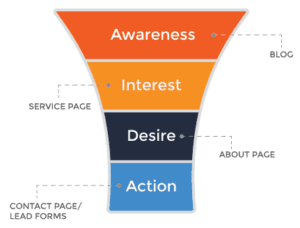
In the awareness stage, consumers are looking for initial information about a service. Today, this almost always starts with a Google search - most often on a mobile device. As a company interested in grabbing the awareness of consumers, SEO is the place to begin. Blogs are often one of the first ways that consumers find your website in Google’s SERP. Craft educational, relevant blog posts that will answer your visitors' questions.
In the interest stage, site visitors are looking for more detailed information about how you could help them - often resulting on them landing on a service page on your site. This transition from a blog post to a detailed page happens most easily through a Call to Action. Strategic CTA placement is key to good web lead generation, including:
So your site visitors have information about the service they were searching for – and after visiting a detailed page on your site, understand whether you’re a good fit for them. How do you build credibility and trust to ensure that the visitor picks YOUR brand over someone else? Your About page. The best way to do this – a genuine About page on your website. Only after you’ve established trust and credibility with the site visitor will you see them convert to a lead.
While the first three stages of the AIDA funnel are based in a certain piece of content on your website, the fourth stage – Action – happens throughout your website. Taking action should be made as easy as possible for website visitors to increase web lead generation opportunities. Getting visitors to take action includes a number of techniques:
Designing a website and content for web lead generation is tricky. The best way to optimize lead generation websites is through testing. Try to vary the placement of CTA’s to see which has more click-throughs. Continue to create content around your user’s thought process and with fine-tuning, you’ll see an increase in your website lead generation effectiveness. OCG Creative is a Reno web design adn internet marketing agency that can help you to design a website or internet marketing content to move visitors through this decision process - and bring you more qualified leads! Explore our capabilities or call 775.324.1644 - we'd love to help you better your business!
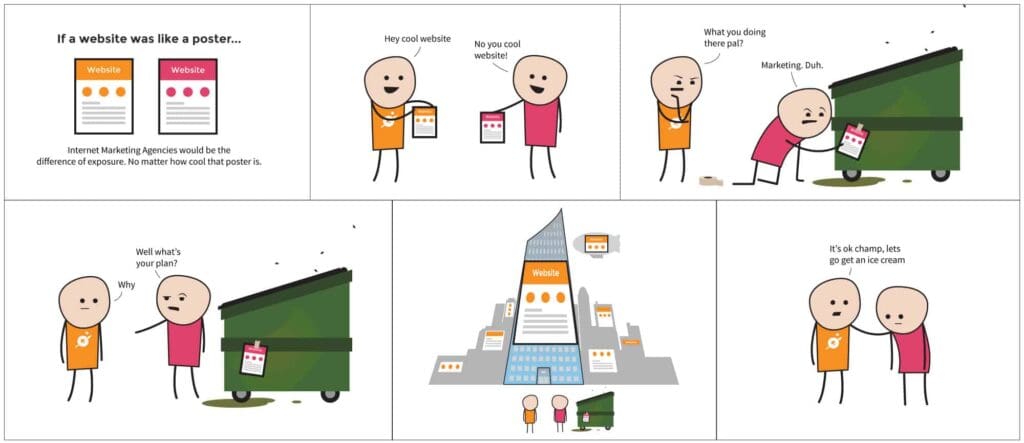
Creativity reigns supreme right? It is common knowledge that only the coolest websites get top exposure. Part of me, as a web designer, hopes this would be true. However, creative web design only takes a business so far. Ultimately, there are thousands of terribly designed websites that get more traffic than award-winners. If you want your website to work for you beyond a cocktail party talking point, then you need to know that Web Design is a part of Internet Marketing and not the same thing.
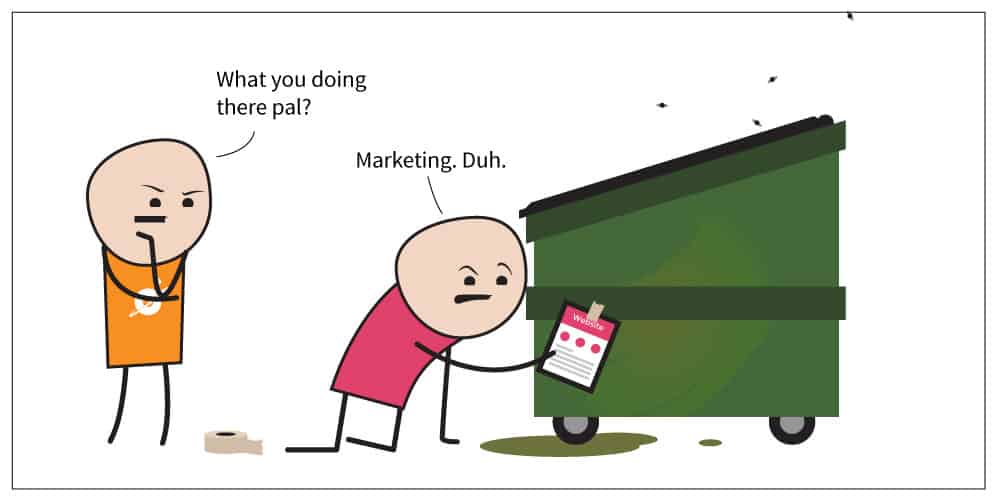
As cleverly explained by the cartoon, you can have the most creative and interesting website in the world, but if you market it horribly, then not many people will see it and you won’t get a very good return on your investment. OCG Creative’s team of dedicated and nerdy Reno web designers and developers work hard to produce these award winning sites. We have done this for numerous clients for many years. Part of the creative web design also involves the user’s experience with the website, which is why an analogy of a website being a poster is only part-true. In reality, a website is a fluid document – it changes with input from the user and looks different on different devices. OCG works to build the coolest website imaginable for our clients, but we know at the end of the day that it is essential to market it correctly, and websites should never stop when the design is completed.
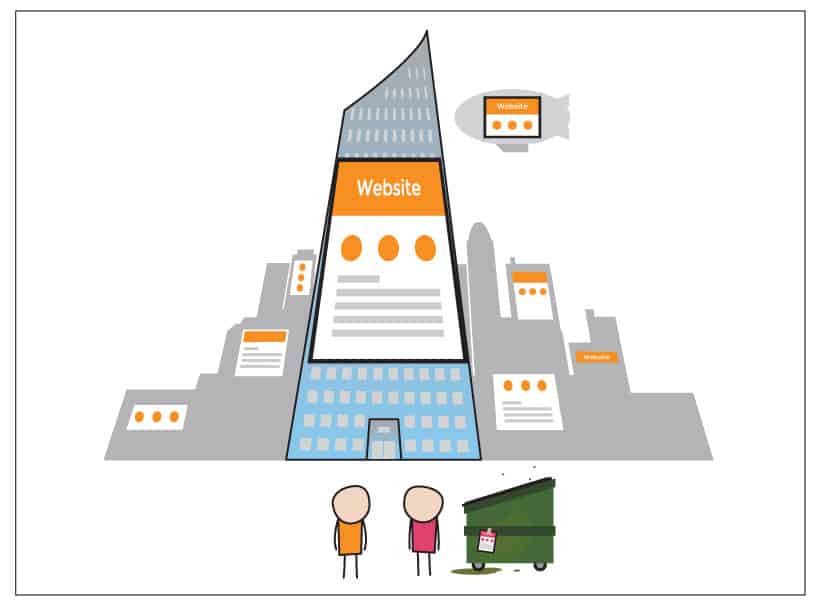
As a secret confession, I used to wonder this question all the time. There are plenty of online tools to build a website, and before I became a web designer, I even built my own portfolio using one of these tools. The issue with all of them… they’re awful. Even discounting the fact that all of them stop at the end of web design, the web design itself is clunky, confusing, and very limiting. I didn’t realize this until I experienced it first hand. A website should never stop at the end of creative web design. Instead, it should be a rocket-powered branding piece pushing the client forward to more exposure and spurring the start of a comprehensive effort to convert website visits into leads. OCG custom designs each website so it is beautiful and branded, but most importantly, they are scalable and sturdy for expansion in traffic and tailored to convert site visitors into customers.
After website design is completed, many people stop and never touch it again. It’s similar to making a cool poster and then never posting it anywhere. Why? Internet marketing takes effort, DIY site builders don’t have the resources to market each site created and the sites themselves are cluttered and reject efforts to market them. A lot of this is due to lack of on-site SEO support in addition to other elements such as effective landing pages and lack of Conversion Rate Optimization. It is much easier to stop after finishing the web design part.
The point is, OCG Creative is a dedicated and experienced Reno web design and internet marketing agency that has the resources. Websites should be built to be optimized for internet marketing. The issue with DIY site builders, is the website's inability to integrate with a meaningful and comprehensive marketing campaign for individual clients. This is because DIY sites purposefully exclude any means of integrating with an internet marketing plan, it is simply too much effort for DIY site builders to accommodate these features. Internet marketing takes time and a sturdy website foundation specifically built for internet marketing. Additionally DIY site builders don't want to manage campaigns because they take time and constant tuning. Hard work with SEO, Landing Pages, CRO, and other services, take time to gain traction. OCG maintains these campaigns, constantly tailoring our client’s Internet Marketing plans to coincide with optimal conversions including tracking page visits and valued keywords to get them ranking higher. You can’t get that level of detailed attention with do-it-yourself websites. It takes significant time, specialized data collection, and informed decisions to be implemented after data collection to market a website correctly.
If you’re not sure where to go from here knowing all of this or if you still think an awesome looking website is the most important thing for you or your business, give us a call or browse our other topics. We’ve been doing this for a while and know the internet marketing world front and back.

 If you want to start an email campaign for your business, you might be tempted to buy a list of leads. Before you do that, I would suggest something even better, and that's building an organic list from your website. Why? Building your email list organically ensures that your leads will actually want to hear from you. It will result in less opt-outs and getting marked as spam. If you get marked as spam too many times, you run the risk of being "blacklisted" or blocked from email servers. If you're new to this, do not fear. You can build your own list through website lead generation.
If you want to start an email campaign for your business, you might be tempted to buy a list of leads. Before you do that, I would suggest something even better, and that's building an organic list from your website. Why? Building your email list organically ensures that your leads will actually want to hear from you. It will result in less opt-outs and getting marked as spam. If you get marked as spam too many times, you run the risk of being "blacklisted" or blocked from email servers. If you're new to this, do not fear. You can build your own list through website lead generation.
Lead generation online consists of building a list of qualified individuals who are interested in your products or services. You can collect this information through forms and calls to action (CTA) on your website. How do you get visitors to fill out forms? Offer something of value. People will exchange their contact information for something that benefits them or sparks their interest. At minimum, you want to collect a name and email address. However, for more extensive offers, you can ask for a mailing address and phone number. Make sure you don't ask for too much information upfront, as it will cause people to bounce off the page. Are you ready to start building your email list? Here are a few different campaigns you can use to start generating leads on your website:
Is your business taking advantage of offering discounts online? Now, this may seem like a no-brainer, but sometimes the best way to get somebody to initiate contact is through an old-fashioned freebie. Giving an attractive discount, free sample, or trial offer can attract leads that otherwise would have kept on clicking. How to do it: Incorporate a free offer or discount into a landing page, pay-per-click ad, or social media ad. Make sure you pick one goal for the user and focus your landing page around that. Learn more about landing pages here.
To blog or not to blog, that is the question. When you blog for your businesses, you create the opportunity to attract new leads by positioning yourself as a thought leader in your industry. You can also position yourself as an expert by creating educational videos, downloadable guides, white-papers and E-books. Offering exclusive content is a great way to build your list and generate leads. How to do it: Integrate a sign up form with your content offer at the end of a blog post or on a landing page. Blog posts are great because your audience is already reading your material and might want more information. Having trouble coming up with content? Read our tips on overcoming writer's block.
You know you love the camera. If not, that’s okay. You can still host an online class or webinar via podcast or voiceover. Do it live or send out recorded sessions—the choice is yours. There’s endless options for connecting with potential leads all over the world now, and turning your office into a virtual classroom. How to do it: Develop your content and promote your class via a landing page that can be shared through ads, social media or on your website. People will exchange their contact info in exchange for the free class. If it’s good enough, it may convert them to a customer! Alright, I have to go do some online shopping. And my coffee is cold. Cue the end of this blog post. Thanks for reading and check back for more marketing tips and lead generation ideas!
If you’ve been brushing up on your web terminology, you may have heard the term “landing page” floating around. What is that exactly? In the marketing world, a landing page refers to a web page designed with one specific purpose in mind: to convert visitors into leads.
Let’s take a minute and break this down into simple terms. These pages solely exists to get visitors (i.e. the people visiting your site) to perform a specific action like filling out a form or clicking a call-to-action. By completing this action, you are able to collect important information about this person or direct them further into the sales funnel. Once you have their information, they became a “lead” that you can add to your database of potential customers.
If you’ve ever been enticed to sign up for an e-book or free sample, there’s a good chance you were lead without even realizing it. A well-designed landing page will persuade you to exchange your contact information for an attractive offer, such as a discount code or newsletter. Basic design elements combined with the right page layout can also help boost your conversion rate.
As mentioned above, these pages help guide visitors toward completing an intended action on a website. By definition, a landing page should not have global navigation linking back to your main website. This keeps visitors from clicking off the page and getting distracted from the main conversion goal. To learn more about how landing pages are used, check out our previous blog post.
Landing pages come in two basic forms: lead generation landing pages, which direct you to fill out a form and click-through landing pages which direct you to another page. Both types are important and serve different purposes to maximize conversions. It does no good to place random forms or buttons all over your website in hopes that people will click them. Instead, placing these strategically on a landing page statistically leads to better conversions. Thanks for reading! We love hearing from you. If you have more questions about landing pages or Reno web design, contact OCG Creative.